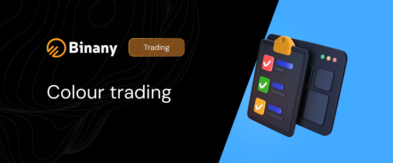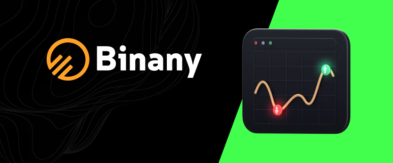Momentum Trading Strategies: Understanding and Putting into Practice
Momentum trading is an approach based on the idea of momentum in finance: if an asset is moving in one direction at a given time, it is likely to continue moving in the same direction in the near future. This strategy focuses on identifying strong trends, supporting them, and using their dynamics to make a profit.

Unlike the traditional approach that analyzes fundamental factors, momentum trading emphasizes quicker responses to shifts in market trends. The main principles of this strategy include: finding assets with high volumes and volatility, using technical analysis to determine entry and exit points, and strictly following risk management rules. The key advantage is that traders benefit from substantial price fluctuations in the market even in the short term. After all, the main focus is on trends. In this context, the Binany platform provides excellent tools for analyzing momentum trading strategies, allowing you to identify and exploit such trends effectively.
How does warrior trading explain momentum trading?
In fact, the explanation of the momentum trading concept in warrior trading is quite simple, but at the same time very useful. First of all, they emphasize the importance of avoiding attempts to predict market reversals and instead focusing on following current trends. In other words, if an asset is growing, it will probably continue to grow until it meets resistance. And conversely, if the market is going down, it is better not to try to “catch the bottom”. By the way, statistics confirm: about 70% of success in this approach is the correct choice of trend, and not the analysis of news or fundamental data.
Understanding Momentum Trading
Momentum traders seek to profit from accelerating prices, targeting assets with strong momentum. This approach requires attention, quick reactions, and, of course, the right tools for analysis.

What Is Momentum Trading
Momentum trading means that assets that show a strong move in one direction have a high chance of continuing that movement. Momentum traders use various indicators and analysis methods to identify these strong trends and use them to their advantage. Essentially, the idea is to follow the trend and not try to counter it, as is the case with other strategies, such as counter-trend approaches.
Binany offers powerful tools for analyzing market momentum, such as charts, indicators, and real-time data. These tools let users quickly identify which assets are currently in a strong movement phase and therefore can be used for a momentum trading system.
Trading Styles Guide: The Basic Principles of Momentum Trading
One of the most important aspects of momentum trading is understanding what factors influence the strength of the current trend. So, the key elements of the strategy include trading volume, price movement, and volatility:
- Volume – the number of assets that were bought or sold over a certain period. The higher the volume, the stronger the signal that the trend is indeed sustainable and has a high chance of continuing.
- Price action – it is important to track not only which way the price is moving, but also its speed. When the price accelerates, this can be a signal to enter a trade.
- Volatility – the higher the volatility, the greater the chance of significant price fluctuations in the short term, which is a great opportunity for a momentum trader.
Why do momentum traders follow price acceleration rather than relying on traditional fundamentals? It’s obvious: fundamentals are often less relevant in the short term. For example, a company may show strong financial results, but its stock may not rise if the market doesn’t believe those figures are sustainable. In contrast, momentum trading focuses on how the price moves.
With the Binany platform, traders can easily track all these key metrics. They monitor price movements, trading volumes in real-time, etc.
How Momentum Trading Differs from Other Strategies
What is the difference between momentum trading and other strategies? This is an important question because knowing the differences helps you choose the most suitable approach for your trading style. Consider the main points:
- Swing trading focuses on longer-term fluctuations, typically from a few days to a few weeks. Momentum trading is based on rapid response to trends that can last only a few hours or days.
- Day trading also deals with short-term movements, but the main emphasis here is on the speed of trade execution and on closing all positions within one day. In momentum trading, what’s crucial is not speed, but the ability to recognize a trend promptly.
- Trend following is a strategy in which traders take positions in the direction of the main trend, but do not always focus on the initial acceleration of the move, as in momentum trading.
Thus, momentum trading is especially suitable for short- and medium-term trades where high market dynamics are important. On the Binany platform, traders can integrate momentum trading strategy into their trading tactics, using tools for analyzing trends, volumes, and volatility to quickly catch strong movements.
How Momentum Trading Works in Practice
Let’s figure out how momentum trading works in practice and how Binany helps to implement it.
Identifying Momentum in the Market
How to spot assets with strong momentum? This is one of the most important steps in momentum trading. Traders usually use several factors. News, company earnings, and market sentiment play a huge role. For instance, if a large company reports results that exceed analysts’ expectations, its stock may start to rise, creating strong momentum. In fact, research shows that news events can impact assets much faster than many traditional analysts factor into their reports.

Binany provides useful tools for momentum identification. Thus, using the platform’s analytical tools, traders can easily track price changes, use indicators, and set notifications so as not to miss the moment when an asset begins to move in the desired direction.
Top 4 Indicators for Momentum Trading
If you want to effectively use a momentum trading strategy, then, of course, it is worth learning how to work with indicators. Some of them are real “guiding stars” for traders. Here are some of the most popular:
- Relative Strength Index (RSI) – this indicator will help you understand when an asset is oversold or overbought. When the RSI goes beyond 70 (overbought), it can be a signal to sell. And if the indicator falls below 30 (oversold), it is a signal to buy.
- Moving Averages (SMA & EMA) – they help to identify the trend direction and its strength. Moving averages (especially EMA) are more sensitive to changes, which makes them useful for momentum day trading. When a short moving average crosses a long one, this is a signal to enter.
- Momentum Indicator – measures the speed of price acceleration, i.e. how quickly the price of an asset changes. This helps to more accurately adjust entry and exit points.
- MACD (Moving Average Convergence Divergence) – this indicator is often called the master of tracking changes in momentum. It shows when moving averages are converging and diverging, which is a strong signal for a change in trend.
Binany offers excellent charting tools. The ability to customize charts, display all values in real time helps traders to react to market changes quickly and use momentum strategies with maximum efficiency.
Entry and Exit Strategies for Momentum Trading
How to determine the best entry moment? It is important to enter the market when the momentum is already warming up. Often, traders use signals such as the intersection of key levels on the charts or the moment when indicators such as RSI or MACD confirm the strength of the current trend.
Don’t forget about exit points. Momentum can change at the most inopportune moment, so you should understand in advance where exactly to close a trade to maximize profits and minimize risks. This can be done by setting a take-profit at a level where the trend is likely to exhaust its strength.
Also, pay attention to stop-loss. Momentum can be very volatile, and it is necessary to have a system of protection against unexpected market changes. Binany offers excellent stop-loss and take-profit features that will help you automate exits, keeping your capital safe.
How to Momentum Trade Successfully: Best Momentum Trading Strategies
There are many momentum trading strategies available today. Some of them are highly effective and are therefore used very often, while others – less often due to their low effectiveness. In the following paragraphs, we will detail the top ones that can be effectively utilized on the Binany platform.
Breakout Trading Strategy
One of the most popular strategies is breakout trading. This method is based on the fact that when the price of an asset breaks through an important support or resistance level, it can move in this direction with a high probability. Key signals for a breakout include:
- an increase in volume;
- acceleration of price movement;
- and technical indicators such as RSI or MACD.
Binany provides convenient tools for analyzing these signals and also helps identify breakouts using customizable charts.
Pullback Momentum Strategy Trading
Sometimes, after a strong price movement, an asset may pause for a while — this is called a pullback. How to trade on a pullback? It is important to distinguish between “healthy” corrections and possible trend reversals. Ideally, traders look for opportunities to enter a pullback when the trend is not changing. On the Binany platform, you can set up alerts so as not to miss such moments and enter a trade in time.
Trend Following with Momentum
Trend following is the basis of long-term momentum trading. Traders accumulate positions in the direction of a strong trend, confirmed through trend indicators. For example, moving averages and RSI help ensure that the trend does not lose its strength. Binany users can easily track such trends and apply the strategy to various assets, from stocks to cryptocurrencies. And this is really a great advantage.
High-Frequency Momentum Trading
For experienced traders who work with short time frames, there is a strategy called high-frequency momentum trading. Every minute counts, and Binany with its high execution speed is ideal for such operations. These traders often use AI and algorithmic strategies to make trades based on short-term changes in market momentum.
Risk Management in Momentum Trading
Momentum trading is undoubtedly an exciting strategy, but it requires proper risk management. It is worth remembering that, like any other trading style, momentum demands a conscious approach to protecting capital. The idea is to minimize losses when the trend reverses, and, conversely, to lock in maximum profits at the right points.
Setting Stop-Loss and Take-Profit Levels
Why are stop losses so important for momentum traders? The answer is simple: to avoid losing everything! Momentum trading is all about fast price movement, and if the trend suddenly changes, it’s important to exit the trade in time. A stop loss helps you lock in your loss at a predetermined level.
Trailing stop is another cool tool. This stop follows the price and adjusts as it moves, locking in profits if the trend continues and preventing losses on reversals. Binany automates these processes, giving you more confidence in your trading.
Avoiding False Breakouts and Market Traps
Market momentum can be false. And if you don’t take all the factors into account, you can get trapped. Hence, it is recommended to use confirming indicators such as RSI or MACD, which will show that the trend is really strong and not temporary. Binany lets you test strategies on a demo account and prevent errors before putting real money at stake.
Managing Leverage and Position Sizing
Leverage can be both a friend and a foe. On the one hand, it allows you to increase your profit potential, but on the other hand, it also increases your risks. When trading momentum stocks, you should correctly place your positions and understand how much you can afford to risk in each trade. Thus, for example, if you are looking to make a short-term profit, it is better to reduce the size of the position to minimize possible losses in the event of a market reversal. Binany offers flexible leverage conditions, so feel free to adapt the strategy to your own goals and risk level.
Why Traders Choose Trading Momentum on Binany
Binany provides unique opportunities for the effective implementation of momentum strategy thanks to a variety of tools and features specifically designed for real-time market analysis.
Real-Time Market Analysis Tools
On the platform, traders have access to powerful modern tools for market analysis, which makes momentum trading convenient and effective. There are all the necessary indicators that help to accurately track trends and make more informed momentum trades. In particular, customizable charts allow identifying the most important moments to enter and exit trades. Moreover, traders can set alerts to not miss moments of strong price momentum. This is especially important for those looking for momentum stocks and want to capture the market movement in time.
Multiple Asset Classes for Momentum Trading
You can choose from various assets:
- Forex;
- stocks;
- cryptocurrencies;
- commodities.
Each of these asset classes can exhibit strong momentum at different times. For example, stocks often perform best when there is positive news, while cryptocurrencies can be very volatile, providing excellent momentum trade opportunities. Choose the best market based on current market conditions.
Low Spreads and Fast Execution
Order execution speed is crucial. Why? Because during market fluctuations, when a strong trend emerges, every second counts. A delay in execution can result in losses, as the momentum move can end as quickly as it began. That is why Binany provides low latency and instant order execution, which is critical for successful trading. The platform’s fast response helps traders take advantage of the high volatility that is typical for assets such as cryptocurrency or stocks, for instance, in momentum stock trading.
Common Mistakes to Avoid in Momentum Trading
We also want to describe the most common mistakes and how to avoid them when trading on the Binany platform.
Overtrading and Chasing Trades
Overtrading is one of the main pitfalls. When the market seems to be moving too strongly, it is tempting to jump into any strong trend, but this can be extremely risky. The most important principle is not to give in to emotions and wait for confirmation of the signal before entering a trade. Not every sharp price is a moment to buy!
On the Binany platform, you can use demo trading to practice patience and not rush into the market without good reason.
Ignoring Market Conditions
Momentum strategies work differently in trending and choppy markets. During periods of uncertainty and low volume, risks increase as momentum trades often turn out to be false. Binany provides an economic calendar to help avoid trading during periods of increased volatility when large price swings not related to real trends are possible.
Poor Risk Management
Ignoring stop losses can quickly lead to lost profits, especially when trading momentum stocks. For example, in the case of sharp volatility, when the price of assets changes instantly, the lack of protection can be fatal. Beginners should limit the use of leverage because although the opportunity to increase profits is attractive, the risk of losses increases many times over.
With Binany’s risk management tools, you can set reasonable stop losses and take profits to control potential expenses.
Conclusion
So, what is momentum in trading? Basically, it is the force that drives the price of an asset to move in a specific direction. The idea is that assets moving in a certain direction are likely to keep moving in the same direction. Momentum stock trading is one of the most popular among active traders, and that’s a fact. Momentum stocks attract attention because of their strong and stable movements. But you can still choose the asset that you like more, be it stocks, Forex, cryptocurrencies, or commodities.
Binany offers all the necessary analysis tools so that traders can effectively implement a day trading momentum strategy, intraday momentum strategy, or any other strategy they choose. The system helps to find the best opportunities and provides traders with up-to-date data, allowing them to make informed decisions and maximize their profits based on current market trends.
FAQ
What is momentum trading?
Momentum trading is a tactic focused on purchasing and selling assets to benefit from current market trends and take advantage of market fluctuations.
Is momentum trading effective?
Yes, if applied correctly. This approach allows traders to profit by following trends rather than trying to guess when the trend will change. However, the strategy requires quick reactions and good market analysis.
Can you make money from momentum trading?
Of course, but it is important to remember that as with any other strategy, there are risks involved. Traders using momentum day trading strategies can make a stable profit if they enter and exit trades on time.
Which indicator is best for momentum trading?
One of the most popular is the Relative Strength Index (RSI), which helps determine when assets are oversold or overbought. Moving Averages and MACD are also often used to analyze stock market momentum.
What are the disadvantages of momentum trading?
The main disadvantage is high volatility, especially in the short term. It is important not to fall into the trap of false breakouts and to apply risk management correctly.
What is momentum in stocks?
Market momentum refers to the direction of asset price movements in the stock market. You should understand when a trend will continue and when it will slow down.
How to buy momentum stocks?
Identify assets showing strong uptrends. Look for confirmation signals and buy when the momentum is still strong.
How to momentum trade?
You need to be disciplined and follow the momentum trading post. Finding strong assets and entering the market on time is the main secret.

Financial writer and market analyst with a passion for simplifying complex trading concepts. He specializes in creating educational content that empowers readers to make informed investment decisions.



